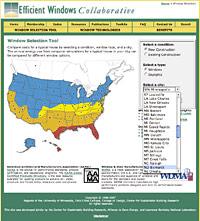Decision-Making Methodology & Selection Tools for High-Performance Window Systems in U.S. Climates

Selecting a glazing system requires an understanding of a series of variables such as, glazing type, frame type, window area, orientation, shading devices, and the use of daylight. These variables that make up the window system all affect the building’s energy performance and the human factor issues relating to the building’s occupants. Using simulation and decision-making tools early in the design process help to understand the impacts of these variables and then these variables can be understood and adopted or rejected early in the design process of a high-performance building.
The decision-making methodology for high-performance window systems can be climate specific. For example, heat gain through the glazing system should be restricted or controlled in a cooling-dominated climate—which may allow for the downsizing of a building’s cooling system. On the contrary, heat gain through the glazing system may be beneficial in a heating-dominated climate—allowing for some passive solar gain. In both these cases, the orientation, glazing type, daylighting (ratio of VT and SHGC), and shading devices are each important but play different roles—all of which impact the design and performance of a building.
Fenestration simulation tools, such as RESFEN (residential) and COMFEN (commercial), give the decision-maker(s) early feedback on the impacts of these variables and aid in integrated design decisions. Both of these simulation tools are developed and maintained by the Windows and Daylighting Group at Lawrence Berkeley National Laboratory (LBNL) and are freely available. These simulation tools, along with paper and web-based tools/information developed by a cooperative effort between LBNL, the Center for Sustainable Building Research, and the Alliance to Save Energy, help in this important decision-making methodology. These tools are not intended to replace whole-building performance simulations, but are targeted as tools to aid in the decision-making process early in the schematic design and development processes.


Add comment
Log in to post comments